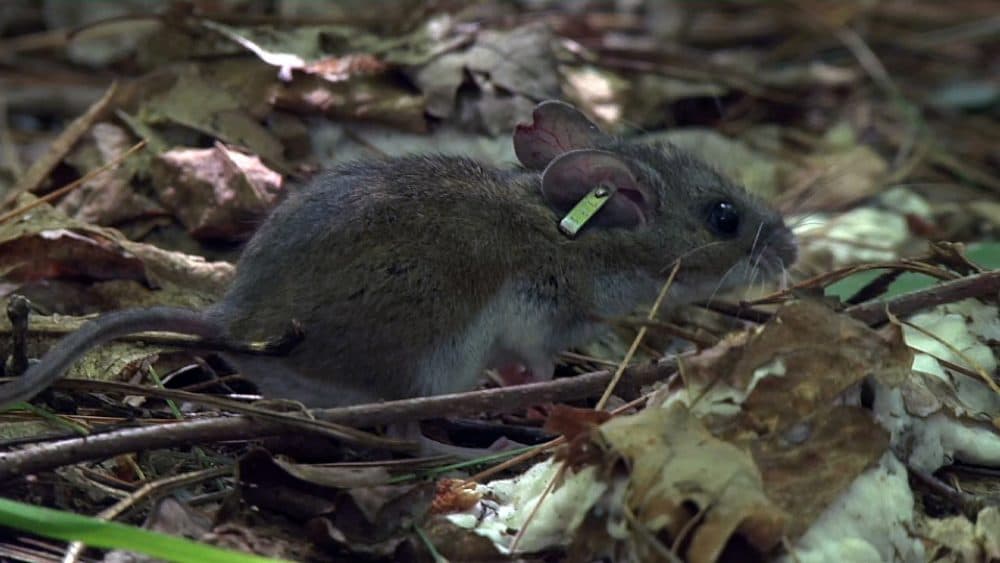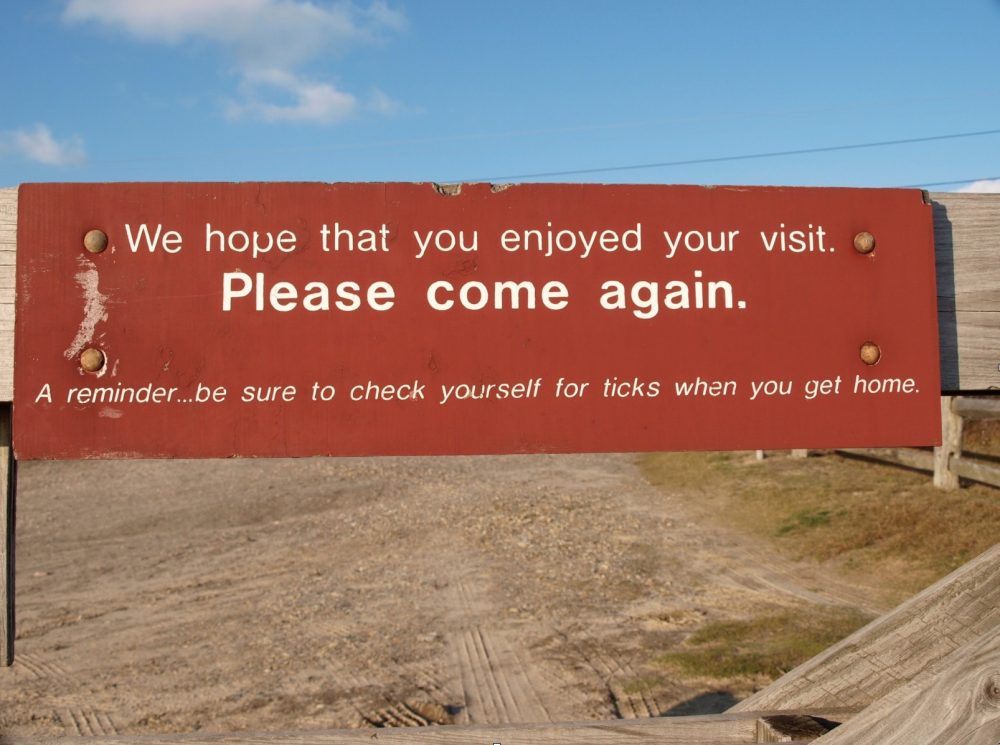Advertisement
Losing to Lyme
One Step Closer To Making Mice That Fight Lyme, Scientists Ask Nantucket: Should We Move Forward?
Resume
Last summer, MIT researchers proposed a futuristic solution for the problem of widespread Lyme disease on Nantucket and Martha's Vineyard: modify the genes of the islands' mice to make them resistant to the tick-borne disease.
If the proposal comes to fruition, it could mean that a few years from now, islanders will witness the first deliberate release of a gene-edited mammal into the environment, says MIT biologist Kevin Esvelt.
On Thursday night, Esvelt and his team plan to update Nantucket residents on the project — and hear from them about whether they want it to move forward.
Graduate student Joanna Buchthal, who has been spending a great many late nights in the lab over recent months, sums up the scientific progress they have to report: "We've succeeded in isolating the DNA sequences for the antibodies that protect mice from Lyme disease. We can take those sequences and integrate them into mouse genomes in order to produce mice that are resistant to Lyme disease."
In effect, the researchers are saying they have hit their first major scientific milestone: If they're going to be editing mouse genes, they've now pinpointed DNA sequences they want to edit in to the mice. And they're also now pursuing another goal in the lab: DNA sequences that could lead to protecting the mice against all tick-borne diseases, not just Lyme.
I spoke this week with Esvelt, who's leading the project his team tentatively calls "Mice Against Ticks." He says Thursday's meeting is meant to update the public both on scientific progress and on the formation of a local steering committee to lead the project. And most of all, he says, it's to hear from residents, who have the power to stop the whole project if they choose.
Malcolm MacNab, chair of Nantucket's Board of Health, says he expects that if the project reaches the point that it's ready to release the mice, it will be brought before the Town Meeting for approval, to be sure of community support. Thus far, he says, resident reaction is seeming somewhat neutral: "There are people who are concerned about it, people who think it's a good idea — we'll have to see."
My conversation with MIT biologist Kevin Esvelt and graduate student Joanna Buchthal, lightly edited, follows.
___
So now that you have the anti-Lyme antibody DNA, what is the next step?
Esvelt: To do the same for the antibodies that protect mice against ticks. This is necessary to reduce the tick population and block the diseases that are not Lyme. We’ve heard pretty loud and clear from the community that they want both, that if you’re going to all the trouble of heritably immunizing the mice, then immunize them against both Lyme disease and ticks in order to try to block all the tick-borne diseases.
And the majority of people also wanted no non-white-footed-mouse DNA in the mice. So that’s why we’re isolating native white-footed-mouse antibodies. So it's immunity from mice, to be encoded back in the mice, the mouse genome, so that it becomes heritable in future generations.
Please spell out a bit more how this works.
When we are exposed to, say, a virus, then several days later we start getting better, then, in future, we can't be infected by that virus again. And that's because our immune system has evolved ways of recognizing that specific virus and destroying it whenever it's encountered.
Similarly, when mice are exposed to the pathogen that causes Lyme disease, then their immune system evolves antibodies that recognize that pathogen. So what we’ve done is exposed mice to the telltale molecules of the Lyme-causing bacterium, the spirochete, and they developed immunity, which was generated by these antibody molecules that specifically recognized that pathogen.
So we’ve then isolated the DNA from these mice that encodes their antibodies, and the next step then would be to encode that mouse DNA back in the mouse genome so that it can be inherited by future generations, because that’s the key: We don’t get to pass our acquired immunity to viruses and bacteria down to our children. That’s not the way the immune system normally works. So all we’re doing is taking the acquired immunity from some white-footed mice and we’re giving them the ability to pass it on to their descendants.
We humans don't develop immunity against the Lyme bacterium — but mice do?
Theoretically, we should, too, given long enough, but it causes a lot of havoc before we do. And it’s possible to generate human immunity — after all there was a Lyme vaccine on the market. It's no longer available, for complex economic and social reasons, but it is entirely possible to generate human immunity.
The problem with that is, even though there is much talk of bringing back some form of human vaccine, that would protect only against Lyme disease. And especially in a place like Nantucket, where the incidence of, in particular, babesiosis and other tick-borne diseases is also very high and rising, protection against Lyme disease may not be enough.
What you're proposing does not involve a "gene-drive system," meaning genetic engineering that would "drive" the genes through the mouse population and make them dominate?
No, it does not involve a gene drive at all. It will simply involve releasing rather a lot of engineered mice. No non-mouse DNA in them, but still, they will have been edited so that they will all be able to pass on this native mouse immunity to their descendants, whereas normally they would not.
How many is 'rather a lot'?
Well, that's a good question. Up to 100,000, we think. But to put that in context, There are typically about 50,000 mice at the end of a Nantucket winter, rising to perhaps 500,000 at the end of fall, when conditions are very good.
So if we release the mice at the lowest point, especially if the community set out lots of traps to reduce the the non-immune population as far as possible before we release the heritable immune mice, then it should mean that future generations of mice, on average, have at least one copy of the mouse-derived genes that make them resistant to these diseases.
But the modified mice would not have any other particular advantage over the wild population?
That's right. In fact, we don't anticipate that this would particularly give the mice any kind of survival advantage. Though it might be nice to be the mice, just because if the anti-tick antibodies work then they wouldn't be infested with ticks all the time. So we don't think it will benefit the mice in anything other than a quality-of-life sense.
What are these anti-tick antibodies?
Here, we're absolutely standing on the shoulders of giants, because many other researchers, including some of our collaborators, have been developing vaccines against some of the molecules in tick saliva. In particular, they target this protein called subolesin. It's the tick's invisibility shield.
That is, it's the centerpiece of the tick's message to our immune system saying, 'There's nothing here to see.' So in a way, immunizing the immune system against this molecule is a way of saying, 'Hey, you might, in the future, see something that's trying to hide from you. And here's the telltale signature of it. So if you ever see it, be on the lookout.'
So the mouse immune system would respond to the tick in a way it doesn't now?
That's right. It would notice that it's trying to be fooled, in a way, and then it would attack the invisibility shield, thereby allowing it to see the rest of the tick saliva, and the tick itself. And in some way that is almost magical, because here we're talking about an immune response at the molecular level, it can be strong enough that it forces the tick to dislodge and fall off.
Question for Joanna Buchthal: So you've succeeded at isolating the antibody gene sequences for anti-Lyme antibodies. How did you do that?
Joanna Buchthal: As the first step, Dr. Sam Telford of Tufts repeatedly vaccinated mice with a Lyme vaccine in order to produce anti-Lyme antibodies. He provided us with samples that we were able to start working with. Our collaborator at another lab at MIT took those samples and from them, he extracted the white blood cells where these antibody DNA sequences are found. By sequencing them and then by using bioinformatics, we could identify the anti-Lyme antibody genes.
And now by inserting those sequences, you can make mice with these antibodies?
Joanna Buchthal: Well, we'll have to test the antibodies in a variety of different ways, first in a Petrie dish and eventually in mice. But at that point, once we're confident — and we're already pretty confident — that they're going to provide a lot of protection, we can integrate those antibody genes into the mouse genome and create mice that are resistant to tick-borne disease for many, many generations.
It took us a very long time to come up with the appropriate technique to actually identify these antibody genes. There was a lot of misdirection, a lot of twists and turns, but eventually we were able to come up with a technique that allows us to actually very quickly identify the cells that have anti-Lyme antibodies on their cell surface.
And at that point it was just a matter of sequencing them and doing quite a bit of bioinformatics, which is actually incredibly difficult because the white-footed mouse species is very different from other species of mouse. The house mouse and the white-footed mouse haven't shared a common ancestor in 25 million years. So we couldn't easily look to another species for a biological road-map.
And now you have to undertake something similar for the anti-tick antibodies? How long will that take?
Joanna Buchthal: We could probably do it in six months, because this first step has succeeded.
So when are you thinking that tens of thousands of modified mice could conceivably be released on Nantucket?
Kevin Esvelt: I would say at least six to seven years from now. Among other things, the community needs to direct a field trial on an uninhabited island.
Also, it's probably time to talk to the actual regulators. We expect the community to be much more stringent — in terms of their demands for transparency and rigor and safe testing — than the regulators would ever be. But nevertheless, legally speaking, you have to go through regulatory approval as well.
But first, you need a continued green light from the community.
Esvelt: The community decides. That's fundamental. That's why this is a little bit anxiety-provoking for us, because now that we've actually done work, well, we're still committed to walking away if the community ever says no. So all of our work could be wasted at this point if the community says no. But we still have to do that, because that's the right thing to do.
Just as we think it's important that the project be community-led from the outset, frankly, the world could use a salutary example of a community saying no and the researchers actually walking away. Much as it's heart-rending to contemplate, and it would leave many disappointed people who are very excited by this, we could probably use that example to build public trust in science right about now.

This segment aired on August 17, 2017.
